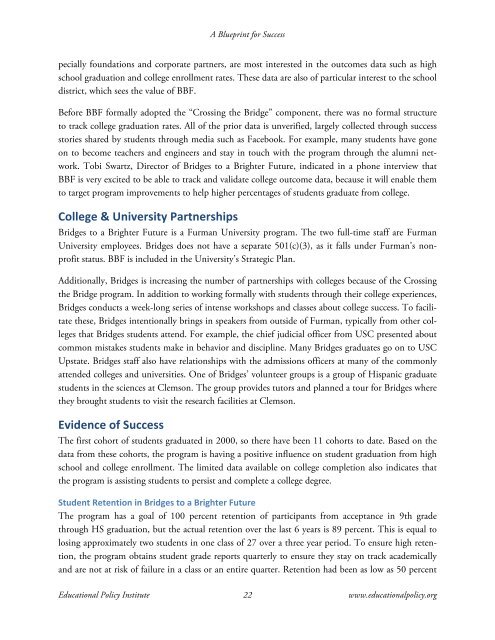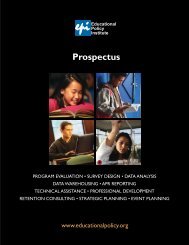A BluePrint for Success: Case Studies of Successful - Educational ...
A BluePrint for Success: Case Studies of Successful - Educational ...
A BluePrint for Success: Case Studies of Successful - Educational ...
Create successful ePaper yourself
Turn your PDF publications into a flip-book with our unique Google optimized e-Paper software.
A Blueprint <strong>for</strong> <strong>Success</strong><br />
pecially foundations and corporate partners, are most interested in the outcomes data such as high<br />
school graduation and college enrollment rates. These data are also <strong>of</strong> particular interest to the school<br />
district, which sees the value <strong>of</strong> BBF.<br />
Be<strong>for</strong>e BBF <strong>for</strong>mally adopted the “Crossing the Bridge” component, there was no <strong>for</strong>mal structure<br />
to track college graduation rates. All <strong>of</strong> the prior data is unverified, largely collected through success<br />
stories shared by students through media such as Facebook. For example, many students have gone<br />
on to become teachers and engineers and stay in touch with the program through the alumni network.<br />
Tobi Swartz, Director <strong>of</strong> Bridges to a Brighter Future, indicated in a phone interview that<br />
BBF is very excited to be able to track and validate college outcome data, because it will enable them<br />
to target program improvements to help higher percentages <strong>of</strong> students graduate from college.<br />
College & University Partnerships<br />
Bridges to a Brighter Future is a Furman University program. The two full-time staff are Furman<br />
University employees. Bridges does not have a separate 501(c)(3), as it falls under Furman’s nonpr<strong>of</strong>it<br />
status. BBF is included in the University’s Strategic Plan.<br />
Additionally, Bridges is increasing the number <strong>of</strong> partnerships with colleges because <strong>of</strong> the Crossing<br />
the Bridge program. In addition to working <strong>for</strong>mally with students through their college experiences,<br />
Bridges conducts a week-long series <strong>of</strong> intense workshops and classes about college success. To facilitate<br />
these, Bridges intentionally brings in speakers from outside <strong>of</strong> Furman, typically from other colleges<br />
that Bridges students attend. For example, the chief judicial <strong>of</strong>ficer from USC presented about<br />
common mistakes students make in behavior and discipline. Many Bridges graduates go on to USC<br />
Upstate. Bridges staff also have relationships with the admissions <strong>of</strong>ficers at many <strong>of</strong> the commonly<br />
attended colleges and universities. One <strong>of</strong> Bridges’ volunteer groups is a group <strong>of</strong> Hispanic graduate<br />
students in the sciences at Clemson. The group provides tutors and planned a tour <strong>for</strong> Bridges where<br />
they brought students to visit the research facilities at Clemson.<br />
Evidence <strong>of</strong> <strong>Success</strong><br />
The first cohort <strong>of</strong> students graduated in 2000, so there have been 11 cohorts to date. Based on the<br />
data from these cohorts, the program is having a positive influence on student graduation from high<br />
school and college enrollment. The limited data available on college completion also indicates that<br />
the program is assisting students to persist and complete a college degree.<br />
Student Retention in Bridges to a Brighter Future<br />
The program has a goal <strong>of</strong> 100 percent retention <strong>of</strong> participants from acceptance in 9th grade<br />
through HS graduation, but the actual retention over the last 6 years is 89 percent. This is equal to<br />
losing approximately two students in one class <strong>of</strong> 27 over a three year period. To ensure high retention,<br />
the program obtains student grade reports quarterly to ensure they stay on track academically<br />
and are not at risk <strong>of</strong> failure in a class or an entire quarter. Retention had been as low as 50 percent<br />
<strong>Educational</strong> Policy Institute 22 www.educationalpolicy.org




